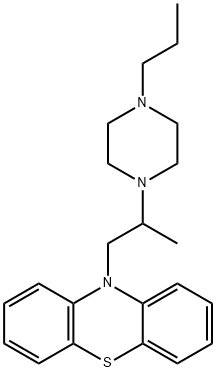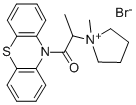ETHOPROPAZINE
- CAS NO.:522-00-9
- Empirical Formula: C19H24N2S
- Molecular Weight: 312.47226
- MDL number: MFCD00242639
- EINECS: 2083204
- SAFETY DATA SHEET (SDS)
- Update Date: 2022-12-21 16:56:50

What is ETHOPROPAZINE?
Absorption
Well-absorbed from the gastrointestinal tract.
Toxicity
Symptoms of overdose include severe clumsiness or unsteadiness, severe drowsiness, severe dryness of mouth, nose, or throat, fast heartbeat, shortness of breath or troubled breathing, and warmth, dryness, and flushing of skin.
Originator
Parsidol,Warner Lambert,US,1954
The Uses of ETHOPROPAZINE
antiparkinsonian, anticholinergic
Indications
Profenamine is indicated in the symptomatic treatment of drug-induced extrapyramidal reactions and of the manifestations (rigidity, akinesia, sialorrhea, oculogyric crisis, tremor, etc.) of Parkinson's disease of encephalitic, arteriosclerotic or idiopathic origin. It is also used to control severe reactions to certain medicines such as reserpine.
Background
Profenamine (also known as ethopropazine) is a medication derived from phenothiazine. It is primarily used as an antidyskinetic to treat Parkinsonism. It is sold under the trade name Parsitan in Canada. In the US, the marketing of profenamine has been discontinued.
Definition
ChEBI: A member of the class of phenothiazines that is phenothiazine in which the hydrogen attached to the nitrogen is substituted by a 2-(diethylamino)propyl group. An antimuscarinic, it is used as the hydrochloride for the symptomatic treatment of Parkinson's d sease.
Manufacturing Process
6.2 grams of phenthiazine in 100 cc of warm dry benzene was added during 1
hour with stirring, and in an atmosphere of hydrogen, to the Grignard reagent
prepared from 1 gram of magnesium, 6.2 grams of methyl iodide, and 20 cc
of dry ether. After boiling for 30 minutes, a solution of 6.6 grams of 2-chloro-
1-diethylamino propane in 10 cc of dry benzene was added during 1 hour to
the boiling solution, and heating was maintained for a further 1.5 hours.
The reaction mixture was then cooled and treated with aqueous ammonium
chloride and chloroform added to dissolve an oil at the interface of the
benzene and aqueous layers. The chloroform-benzene extract was extracted
with 2 N hydrochloric acid and the acid extract was basified at 5° to 10°C with
50% aqueous sodium hydroxide.
There was obtained a mixture of N-(2'-diethylamino-2'-
methylethyl)phenthiazine and N-(2'-diethylamino-1'-methylethyl)phenthiazine
in the form of a viscous yellow oil, BP 202° to 205°C/2 mm. This oil was
treated in ethereal solution with ethereal hydrogen chloride and gave a white
solid which was fractionally crystallized from ethylene dichloride. The less
soluble fraction, N-(2'-diethylamino-2'-methylethyl)phenthiazine hydrochloride
formed colorless rhombs, MP 223° to 225°C. The more soluble N-(2'-
diethylamino-1'-methylethyl)phenthiazine hydrochloride was obtained as
colorless prismatic needles, MP 166° to 168°C.
Therapeutic Function
Antiparkinsonian
Pharmacokinetics
Profenamine, a phenothiazine and antidyskinetic, is used in the treatment of Parkinson's disease. By improving muscle control and reducing stiffness, this drug permits more normal movements of the body as the disease symptoms are reduced. It is also used to control severe reactions to certain medicines such as reserpine, phenothiazines, chlorprothixene, thiothixene, loxapine, and haloperidol. Unlike other NMDA antagonists, profenamine — because of its anticholinergic action — is largely devoid of neurotoxic side effects. Profenamine also has a slight antihistaminic and local anesthetic effect.
Safety Profile
Poison by ingestion, subcutaneous, and intravenous routes. An anticholinergic agent used to treat Parkinson's dsease. When heated to decomposition it emits very toxic fumes of NOx and SOx.
Metabolism
Not Available
Properties of ETHOPROPAZINE
| Melting point: | 53-55° |
| Density | 1.1070 (rough estimate) |
| refractive index | 1.5800 (estimate) |
| storage temp. | -20°C |
Safety information for ETHOPROPAZINE
Computed Descriptors for ETHOPROPAZINE
New Products
4-AMINO-TETRAHYDRO-PYRAN-4-CARBOXYLIC ACID HCL 4-(Dimethylamino)tetrahydro-2H-pyran-4-carbonitrile 4-Aminotetrahydropyran-4-carbonitrile Hydrochloride (R)-3-Aminobutanenitrile Hydrochloride 3-((Dimethylamino)methyl)-5-methylhexan-2-one oxalate 1,4-Dioxa-8-azaspiro[4.5]decane 5-Bromo-2-nitropyridine Nimesulide BP Aceclofenac IP/BP/EP Diclofenac Sodium IP/BP/EP/USP Mefenamic Acid IP/BP/EP/USP Ornidazole IP Diclofenac Potassium THOMAIND PAPER PH 2.0 TO 4.5 1 BOX BUFFER CAPSULE PH 9.2 - 10 CAP SODIUM CHLORIDE 0.1N CVS ALLOXAN MONOHYDRATE 98% PLATINUM 0.5% ON 3 MM ALUMINA PELLETS (TYPE 73) LITHIUM AAS SOLUTION 2-Bromo-1-(bromomethyl)-3-chloro-5-nitrobenzene 2-Bromo-3-nitroaniline N-(3-Hydroxypropyl)-N-methylacetamide 3-Bromo-6-chloropyridazine 4-ethyl-3-nitrobenzoic acidRelated products of tetrahydrofuran








You may like
-
 1-Methyl-6-oxo-1,6-dihydropyridazine-3-carbonitrile 98%View Details
1-Methyl-6-oxo-1,6-dihydropyridazine-3-carbonitrile 98%View Details
99903-60-3 -
 88491-46-7 98%View Details
88491-46-7 98%View Details
88491-46-7 -
 1823368-42-8 98%View Details
1823368-42-8 98%View Details
1823368-42-8 -
 2-(3-(tert-butyl)phenoxy)-2-methylpropanoic acid 1307449-08-6 98%View Details
2-(3-(tert-butyl)phenoxy)-2-methylpropanoic acid 1307449-08-6 98%View Details
1307449-08-6 -
 Ethyl 3-(furan-2-yl)-3-hydroxypropanoate 25408-95-1 98%View Details
Ethyl 3-(furan-2-yl)-3-hydroxypropanoate 25408-95-1 98%View Details
25408-95-1 -
 2-Chloro-5-fluoro-1-methoxy-3-methylbenzene 98%View Details
2-Chloro-5-fluoro-1-methoxy-3-methylbenzene 98%View Details
1805639-70-6 -
 1784294-80-9 98%View Details
1784294-80-9 98%View Details
1784294-80-9 -
 Lithium ClavulanateView Details
Lithium ClavulanateView Details
61177-44-4